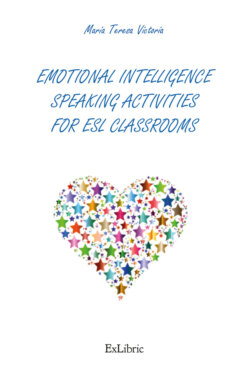Читать книгу Emotional intelligence speaking activities for ESL classrooms - María Teresa Victoria - Страница 13
На сайте Литреса книга снята с продажи.
Оглавление2. Absolute beginners
An ESL teacher for absolute beginners with an emotional intelligence approach will hopefully find this ice-breaker useful when preparing in-class activities for their newly grouped students.
I was wondering what to do in English language with pupils who have not studied English before, how and where to begin if you are not happy with the line “Unit One, page one, exercise one” … when I came up with this suggestion: pick up some good vocabulary activity that is easy and anyone can just enjoy by very simply Listening and Repeating words!
COLOURS - SHAPES - NUMBERS - LETTERS
So after the typical “Introductions” when everyone knows each other’s name, you can ask your group to sit in fours to the count of “One, Two, Three, Four”. All “one’s” will sit together, all “two’s” and so on. Then play the three songs that follow and experience, like explained in the article “ Emotional responses to music” [www.mindfulenglish.net] how in fact “music can actually evoke emotions” and in this first session “get people together” as well.
Each group of four, listens to the three YouTube video songs projected on screen. Allow time for them to give opinions on which one they liked best and why. What is their choice of music when they are in the car or at home, etc. Let them talk as much as they like, considering it is their first day at school. Then they can try and determine what is the common factor in them.
The answer is they all are colour-related songs: the first one sung by the artist Pink, the second one displaying an array of colours of the rainbow, the third one with naming the colour in it.
When you think it is appropriate project the Vocabulary Sheet for Colours and hand out coloured pieces of paper at random. Ask the students to Listen and Repeat to the correct pronunciation of The colours of the rainbow. Try to remember how to pronounce their coloured piece of paper. Then write on their piece of paper their name, number and colour. Like this: Peter – two – blue. Finally ask them to tell the other students in their group what their name is, which number group they belong to, and what colour their piece of paper is, for instance, “My name is Peter. I am number Two. I am blue”. At the end of the lesson they can pin up their papers on the noticeboard as a memento of their first day at school.
IF YOU HAVE TIME:
You can hand out shaped pieces of colour paper as an add-on piece of vocabulary, as follows, my name is Peter, my number is two, I am a blue triangle.
FOR LONGER SESSIONS:
You may like to play The Alphabet song!. It makes it all nice and lively to spread out at random, cut-out letters, or perhaps ask for a volunteer to hand the letters out to their classmates as they are getting in first of all, and then at one point, repeat the sounds of the Alphabet by having each student call out loud their letters one at a time. The effect is very dynamic when you hear the voices of the students from different spots in the classroom like a ping pong ball bouncing from one to another.
You can close up this first session by picking up some colours of your choice to be spelt slowly and quietly as it is their first time. For example, “red”. Ask the students to get up as they hear the sound of the letter written on their cut-out flashcard. Then get them all together somewhere visible where the rest of their classmates can see the whole word that has come up with each one of the letters: R - E - D. And sit back down.
Note that this activity can be used to learn and practice numbers and figures as well!
